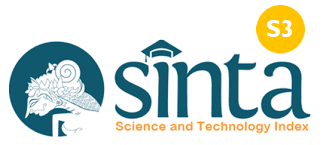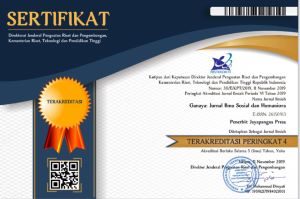Penerapan Model Pembelajaran Berbasis Masalah Untuk Meningkatkan Aktivitas Dan Hasil Belajar Siswa
DOI:
https://doi.org/10.37329/cetta.v3i2.446Keywords:
Problem Based Learning Design, Learning Activities, Learning OutcomesAbstract
This study aims to improve the activities and student learning outcomes of Class IX-G SMP Negeri 5 Amlapura Semester I Academic Year 2018/2019. The subjects in this study were 22 st grade students, amounting to 22 people; consisting of 8 male students; and 14 female students, in the first semester of the 2018/2019 school year. This study uses a class action research design through two stages. Student learning activity data is collected by observation sheets, and learning outcome data is collected by multiple choice tests. Both types of data were analyzed by quantitative descriptive methods. Before the two stages are carried out, the initial observation activities are conducted by the students' learning activities, and analyzing the questions of UTS Indonesian Language Class IX semester I of academic year 2018/2019. The activity was carried out to determine the level of initial activity and student learning outcomes before the implementation of the Problem Based Learning model. The results of this study indicate that the application of the Problem Based Learning design can increase learning activities and Indonesian language learning outcomes of Class IX-G SMP Negeri 5 Amlapura semester I of 2018/2019, namely in the initial observation of low student learning activities, increasing from an average of 59,77 and completeness 13,63% in the first stage, in the second stage the average student learning activity was 81.25 and the completeness level was 86,36%. While student learning outcomes increased from an average of 68,18, absorbency of 68,18%, and classical completeness level of 50,00% at initial reflection, increased to an average of 69,09, absorptive capacity of 69,09%, and the level classical completeness was 59,09% in stage I. In stage II it increased to an average of 77,27, absorbency 77,27%, and classical completeness rate 90,91%. Based on these results the researchers formulated suggestions; (1) Students are expected to be able to utilize this Learning design to improve their learning activities and outcomes; (2) Other teachers can apply this learning design, by examining the weaknesses of the results of this study; (3) Schools can make consideration material as one of the learning design that can be developed to solve learning problems in class; (4) Other researchers can make the results of this study a relevant research study.
References
Agustawan, G. E. (2006). Implementasi model pembelajaran berbasis masalah dalam pembelajaran fisika sebagai upaya meningkatkan kompetensi dasar fisika dan kemampuan berpikir kritis siswa kelas VIIIB SMP Negeri 2 Singaraja tahun ajaran 2005/2006. Skripsi (tidak diterbitkan). Jurusan Pendidikan Fisika, IKIP Negeri Singaraja.
Arnyana, I B. P. (2007). Penerapan model PBL pada pelajaran biologi untuk meningkatkan kompetensi dan kemampuan berpikir kritis siswa kelas X SMA Negeri 1 Singaraja tahun pelajaran 2006/2007. Jurnal Pendidikan dan Pengajaran. 40(2). 231-251.
Depdiknas. (2005). Bahasa dan Sastra Indonesia, Materi Pelatihan Terintegrasi. Buku 3. Jakarta: Dirjen Dikdasmen.
Ibrahim, M., & Nur, M. (2000). Pengajaran berdasarkan masalah. Surabaya: Unesa Universitas Press.
Kunandar. (2008). Langkah Mudah Penelitian Tindakan Kelas. Jakarta: PT. Raja Grafindo Persada.
Mulyadi, I. N. (2019). Penerapan Model Pembelajaran Mastery Learning Untuk Meningkatkan Prestasi Belajar Matematika Siswa Kelas IXB SMP Negeri 3 Selat. Cetta: Jurnal Ilmu Pendidikan, 2(2), 289-296.
Nurgiantoro, B. (2001). Penilaian dalam Pengajaran Bahasa dan Sastra. Yogyakarta: PT. BPFEE-Yogyakarta.
Nurhadi., Yasin, B., & Senduk, A. G. (2004). Pembelajaran kontekstual (Contextual Teaching and Learning/CTL) dan penerapannya dalam KBK. Unit Penerbit Universitas Negeri Malang.
Nurkancana, W. d& PPN Sunartana. (1992). Evaluasi Hasil Belajar. Surabaya: Usaha Nasional.
Sudarman. (2007). Problem based learning: suatu model pembelajaran untuk mengembangkan dan meningkatkan kemampuan memecahkan masalah. Jurnal Pendidikan Inovatif. 2(2). 68-73. Online. Dapat diakses pada http://www.jurnaljpi.files.wordpress.com/2007/09/04sudarman.pdf. (Diakses pada tanggal 26 September 2007).
Tim Kurikulum SMP Negeri 5 Amlapura. (2018). Kurikulum SMP Negeri 5 Amlapura Tapel 2018/2019. Amlapura: SMP Negeri 5 Amlapura.
Downloads
Published
How to Cite
Issue
Section
License
An author who publishes in the Cetta : Jurnal Ilmu Pendidikan agrees to the following terms:
- Author retains the copyright and grants the journal the right of first publication of the work simultaneously licensed under the Creative Commons Attribution-ShareAlike 4.0 License that allows others to share the work with an acknowledgement of the work's authorship and initial publication in this journal
- Author is able to enter into separate, additional contractual arrangements for the non-exclusive distribution of the journal's published version of the work (e.g., post it to an institutional repository or publish it in a book) with the acknowledgement of its initial publication in this journal.
- Author is permitted and encouraged to post his/her work online (e.g., in institutional repositories or on their website) prior to and during the submission process, as it can lead to productive exchanges, as well as earlier and greater citation of the published work (See The Effect of Open Access).
Read more about the Creative Commons Attribution-ShareAlike 4.0 Licence here: https://creativecommons.org/licenses/by-sa/4.0/.





